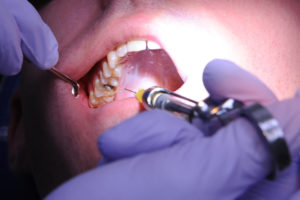You might not accept it, but your teeth can be troublesome for you. We do not consider our teeth as living things, but they contain live tissues and nerves. Our mouths are a breeding place for good as well as bad bacteria, which can lead us to varied dental issues. Dental problems are painful and discomforting; nevertheless, the good news is that most of the dental problems can be easily prevented and treated. Some of the common dental problems include gum line cavity, erosion, tooth decay, and sensitive teeth at gum line. Here is an article including an overview of common dental problems and their causes.

Our mouth is under a lot of strain; it has to perform tasks like talking, grinding, chewing, biting every single day of our lives. In order to keep our mouth healthy, it is essential to provide it with little care and love. It means brushing teeth and attending regular check-ups at nearby dental clinics. Moreover, it also includes eating a healthy diet.
Nevertheless, dental problems can also occur in people with excellent dental care routines. Hence, it is essential to identify the signs of underlying dental issues. You should learn how to identify dental problems so that you can respond efficiently as well as quickly.
This is a guide to some of the common dental problems and their causes, which will help you in understanding and identifying the dental problems so that you can respond to them properly.
Problem One: Gum Line Cavity
Cavity is a discomforting issue, but if you are diagnosed with cavities, then trust me, you are not alone. The cavity is one of the most common dental issues. The cavity can form between teeth, in grooves and pits of the molar, and even along the gumline.
What is the Gumline Cavity?
Cavities are the damaged areas in the hard surface of the teeth, which lead to tiny holes. The cavity is also known as tooth decay, and it is caused as a result of a number of combinations of factors, including the bad bacteria present in your mouth.
It is softening of the enamel of your teeth and is also damage to the tooth structure caused due to acids created by breaking down the sugar by the plaque bacteria in your mouth. If this mineral loss is left untreated, then it leads to a hole in the tooth known as the cavity. If cavities are not treated at the correct time, then they get larger and affect the deeper layers present in your teeth.
What are the Symptoms of Cavity?
The signs and symptoms of cavities differ based on their location and extent. At the initial stage of the cavity, you might not notice any symptoms at all. When the cavity gets larger, it might reflect the below-mentioned symptoms.
- Toothache
- Spontaneous pain without any apparent cause
- Tooth sensitivity
- Pain while chewing or biting down
- Pits or visible holes in your teeth
- Mild pain while drinking or eating something hot, cold or sweet
- Black, white, or brown stains on the surface of your teeth
What Causes Cavity?
Below mentioned are some of the common causes of cavities.
- Poor Oral Hygiene – Not brushing teeth on a regular basis allows the plaque to develop and attack the enamel of the tooth
- Formation of Plaque – Plaque develops when food particles, acid, bacteria, and saliva combine in your mouth. This plaque stays in your teeth and increases over time. The acid present in the plaque attacks your tooth’s enamel, which in turn leads to a hole in your teeth, also known as cavities.
- Eating and Drinking – This is where the cavity begins. The type of food you eat develops an impact on the formation of cavities. When you drink or eat the carbohydrates remain in your teeth until you clean your mouth and brush your teeth. Foods that cling to your teeth leads to the development of cavities.
- Dry Mouth – Saliva formed in the mouth helps in washing away the plaque. When you have dry mouth, plaque stays in your mouth and leads to the development of cavity.
- Medical Issues – Some medical issues can lead to the tooth cavity by leading the acid present in your stomach to flow back in your mouth. Bulimia is another medical issue that increases the risk of cavities.
Problem Two: Enamel Erosion
Tooth enamel erosion refers to the erosion of enamel, which is the substance that protects your teeth against chemical and physical damage. Tooth enamel is tough and is a protector of your teeth. Enamel is the first layer of your teeth, and it provides your teeth defense against different chemicals from body fluids and foods. As a result, the enamel is highly prone to erosion.
What are the symptoms of erosion?
- Tooth stains
- Discoloration
- Increased sensitivity to temperature, taste, and texture
- Chips and cracks
- Indentations on teeth’s surface
Over time, erosion can result in below-mentioned complications
- Stained or yellow teeth
- Increased decay of tooth
- Shiny spots on teeth
- Rough edges
- Highly sensitive teeth
What Causes Erosion?
One of the primary causes of erosion is acids found in liquids and foods you consume. If you eat food that is too acidic and do not brush your teeth properly, then the outer layer of enamel starts degrading over time. Below mentioned are some common causes of erosion.
Sugary foods like caramel, syrups, and ice creams
Acidic foods like citrus fruits, apples, and berries
Fruit drinks and juices
Sodas that contain damaging phosphoric and citric acid as well as sugar
Foods containing a higher amount of vitamin c
Other causes of erosion are as follows
- Teeth grinding
- Eating disorders that disrupt the digestive system
- The low flow of saliva
- Regular use of specific medical conditions like aspirin or antihistamine
- Acid reflux
Problem Three: Ridges on Teeth
Ridges on teeth is one of the common dental issues faced by children. Ridges grow over the edges of the new teeth of children. Most of the parents get worried about it, but no need to panic as it is totally normal. These ridges on teeth are known as “mamelons.” They appear on new adult teeth due to the way they grow.
Ridges do not last for a longer time, and they end up wearing down.
What are the Causes of Ridges on Teeth?
Ridges on teeth are completely normal, and they develop as a result of enamel fusing together when the tooth is developing. All the front teeth develop from varied parts known as lobes. These lobes fuse together before poking of a tooth through the gum tissue along with the pink pony gingival ridge. These enamel serrations prob the tooth through gums, which leads to an eruption of the entire tooth.
If your kid has ridges on their teeth, then you don’t need to worry as it wears down over time on their own. If you are worried about the mamelon teeth, then you can visit dental professionals, they can polish them appropriately.

Problem Four: Sensitivity
Tooth sensitivity is one of the most common dental problems. It can develop over time due to common issues like enamel wear or receding gums. It involves pain or discomfort in teeth while encountering specific temperatures and substances. The pain caused due to sensitivity is sudden and sharp; nevertheless, it is temporary.
What are the Symptoms of Tooth Sensitivity?
Sensitive teeth lead to experiencing discomfort or pain as a result of specific triggers. Below mentioned are some of the most common triggers of sensitivity.
- Cold air
- Cold beverages and foods
- Hot beverages and foods
- Sweet drinks and foods
- Mouth rinses containing alcohol
- Acidic drinks and foods
- Coldwater
- Flossing teeth
What are the Causes of Tooth Sensitivity?
Below mentioned are some of the factors that contribute to sensitive teeth
- Using hard toothbrush
- Grinding teeth at night
- Regularly consuming acidic foods and beverages
- Brushing teeth too hard
- Plaque buildup
- Cracked teeth
Problem Five: Tooth Decay at Gum Line
People above the age of 50 get more cavities as compared to children, and they face different types of tooth decay, and tooth decay at the gum line is one among them. Tooth decay at the gum line is also known as root decay.
What are the symptoms of tooth decay at the gum line?
Some of the symptoms of tooth decay at the gum line are as follows-
- Tooth sensitivity
- Pain when you bite something
- Sharp or mild pain while drinking or eating something sweet
- Visible holes
What are the causes of Tooth Decay at Gum Line?
If you are facing the issue of tooth decay at the gum line, it means you have a bacterial infection at the surface of the tooth. These bacteria lead to the development of acids that erode the tooth’s soft part at the gum line. Some other causes of tooth decay at the gum line are as follows-
- Smoking
- Dry Mouth
- Gum disease
- Receding gums
Dental problems can be avoided by following an appropriate oral health routine. If you can spend a lot of time in the gym to keep your body fit, or you can spend time in beauty salons for skincare, then you should also show some dedication to oral hygiene. Managing oral health will not only help you in avoiding dental problems but will also help you in managing a healthy mouth.


















